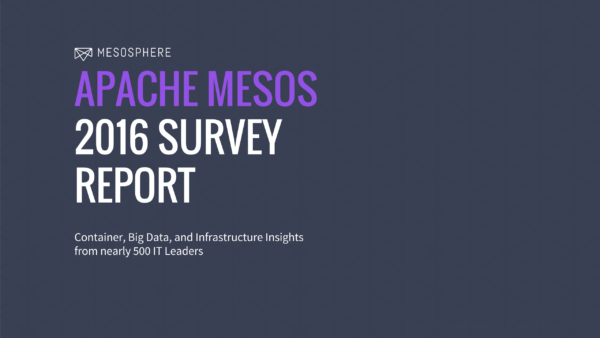In August 2016, we conducted a survey to better understand how Apache Mesos is used and how to make it better. The survey - which collected nearly 500 responses from Mesos users across the globe - highlights the strong growth of Mesos and provides invaluable insights into how Mesos is enabling the adoption of containers and big data services.
In particular, the results show:
- The Mesos community is growing fast, as is the size of users' Mesos deployments once they see what it can do.
- Mesos is driving the adoption of modern applications - container orchestration and big data services are key drivers of Mesos use.
- Users see a tremendous amount of value in the features that DC/OS provides on top of Mesos, and it shows in the data: the vast majority of new Mesos users use DC/OS to get started.
Here are some more specific findings from the survey.
Mesos adoption is growing with influx of new users
Building on Mesos' strong adoption by leading companies like Twitter, Netflix and Uber, Mesos is gaining traction with a large influx of new users: 63% of respondents have been using Mesos for less than a year.
While webscale is common, more users start small
While Mesos was engineered for very large scale, it continues to attract companies of all sizes. Of respondents surveyed, 43% came from companies with less than 200 employees. The majority of respondents are running clusters with fewer than 100 nodes, but as companies use Mesos for longer periods of time, the average cluster size grows significantly.
Mesos is deployed across clouds and datacenters
Mesos users are demonstrating expertise deploying and managing modern applications across a variety of environments, both locally and in the cloud. Modern applications built using microservices are much more likely to be deployed in a hybrid or cloud model compared to monolithic applications.
Mesos is driving the transition to modern apps
Mesos is leading the transition to modern applications, with 85% of respondents running containers with a microservices architecture, and 62% of respondents running containers in production. But modern apps aren't only based on stateless code; Mesos allows users to easily deploy and operate data services such as Spark and Kafka, and the survey showed that 68% of Mesos users are doing just that.
Container orchestration and big data are key drivers of use
The most commonly used frameworks on Mesos are Marathon (for container orchestration) and big data frameworks, used by 83% and 68% of respondents, respectively. And users aren't just deploying one type of workload on Mesos: the average user runs 3 or more frameworks. Apache Spark (which was originally created as a demo for Mesos) continues to be the most widely deployed data service.
DC/OS is enabling broad Mesos adoption
Since
DC/OS was
open sourced in April 2016, it has become the de facto platform for Mesos users, with 87% of respondents who first tried Mesos in the past six months having experienced it as a component of DC/OS. Over a quarter of all respondents reported they either used DC/OS in production or were deploying it with the intent to use in production.
Conclusion
An ever-growing list of organizations are using Mesos and contributing back to the community, and these insights will guide our work as we continue to build the Mesos and DC/OS projects.
We also want to give a big thank you to everyone who participated in the Apache Mesos Survey 2016. All your feedback provided us a better picture of who is using Mesos, how they're deploying it, and the workloads they're running on it.












